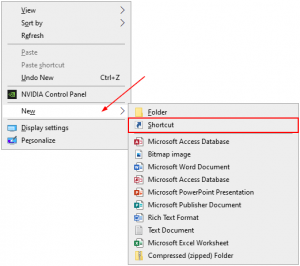
- SOUND CONTROL PANEL SHORTCUT HOW TO
- SOUND CONTROL PANEL SHORTCUT INSTALL
- SOUND CONTROL PANEL SHORTCUT WINDOWS
SOUND CONTROL PANEL SHORTCUT HOW TO
In last month’s column, I showed you how to create shortcuts to Control Panel applets such as Add Or Remove Programs by dragging them onto your Quick Launch bar. Other applets, though, are so useful you’ll want to make them as easy to get at as possible.
SOUND CONTROL PANEL SHORTCUT INSTALL
For example, the Java Plug-in control, which makes an appearance in the Control Panel if you install any version of the Java Runtime Engine, is something most of us never need to touch. Some Control Panel applets are pretty esoteric and you’re unlikely to call on them often, if at all. Note, if you use the Display As Menu option for the Control Panel, you can still open the standard Control Panel window by clicking Start and then right-clicking the Control Panel option in the Start Menu and selecting Open from the pop-up menu.

I prefer the former because I like to create shortcuts to only those applets I use often – I’ll show you how soon I can do without the others cluttering up my Start Menu. The former (the default) simply displays a Control Panel option on the Start Menu the latter displays the Control Panel option with a cascading menu providing direct access to each Control Panel applet.

On the Start Menu tab, make sure the first (non-classic) Start Menu option is selected and click Customize.Right-click the Start button and choose Properties from the pop-up menu.If it’s not on your Start Menu, it’s easy to add: You open the Control Panel by clicking Start -> Control Panel. It may be a little intimidating to start with, but it makes it much easier to track down all the Control Panel items and reduces the number of clicks required to access them. In Classic View, all the applets are dumped into the one folder. The other way to view the Control Panel is by the Classic View, familiar to anyone who has used the Control Panel in previous versions of Windows.
SOUND CONTROL PANEL SHORTCUT WINDOWS
This is where Windows puts Control Panel applets installed by third-party applications, such as a QuickTime control or a special display control for your video card. There’s actually a tenth category – easy to miss as it is only available via the task pane – called Other Control Panel Options. The default mode, in the Home Edition, is the colourful and friendly Category View, which divvies up the Control Panel applets into nine categories: Appearance and Themes Network and Internet Connections Add or Remove Programs Sounds, Speech, And Audio Devices Performance and Maintenance Printers and Other Hardware User Accounts Date, Time, Language and Regional Options and Accessibility Options. In Windows XP, the Control Panel has two modes.

While many of the settings in the Control Panel are also accessible in other ways – for instance, you can change the desktop appearance by right-clicking the desktop and choosing Properties from the pop-up menu or by opening the Display applet in the Control Panel – the Control Panel makes it easy to keep tabs on all your Windows settings. From the Control Panel you can adjust and tweak Windows’ appearance, performance, network connections, hardware settings and a whole lot more. The Control Panel centralises access to Windows’ multitudinous settings.


 0 kommentar(er)
0 kommentar(er)
